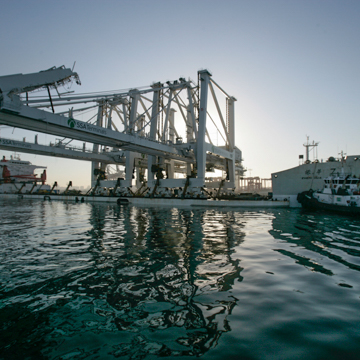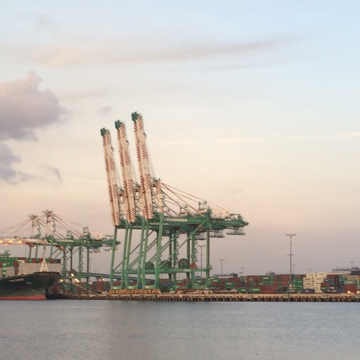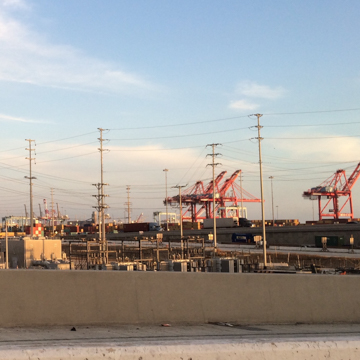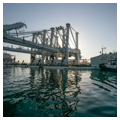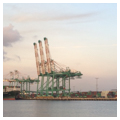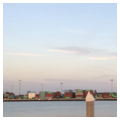The Port of Long Beach, situated two miles southwest of the town’s core and 25 miles south of downtown Los Angeles, is second only to the adjacent Port of Los Angeles as the nation’s busiest container port (where cargo is unloaded from ships and boarded onto vehicles for further transportation). As an international trading hub, the port acts as a gateway to Asia, generates $100 billion per annum, and employs hundreds of thousands of Los Angeles County inhabitants. The industrial complex—composed of wharves, cargo terminals, roadways, railyards, bridges, and sea channels—is an entirely human-made landscape at the mouth of the Los Angeles River, in which sloughs and salt marshes were dredged at the turn of the twentieth century to create the inner harbor. It has since expanded to encompass 3,200 acres with 25 miles of coastline. The scale of the industrial enterprise is difficult to visualize, but the port is a vast infrastructural city that exemplifies the Machine Age aesthetic, with brighter lights than the towns that surround it, billowing smokestacks, coal heaps the size of small hills, colossal cranes, fields of freight, docked ironclad vessels, industrial buildings, and a massive web of highways, bridges, and arterial roads.
In 1897, the same year it incorporated as a city, Long Beach (then a small, agricultural community and seaside resort) experienced a watershed moment when the federal government selected it over Santa Monica for the construction of a deep-water port. Between 1899 and 1949, an 8.5-mile breakwater was constructed in San Pedro Bay, the channels of which would allow large ships to access docking piers within. In 1904, four years before he became Long Beach’s first mayor, Charles H. Windham (1871–1932) recognized the value the undesirable mudflats of the delta would have once the breakwater was completed and purchased 800 acres. In 1906, he formed the Los Angeles Dock and Terminal Company, and by the following year, construction of the harbor’s first shipyard was underway. In 1909, Long Beach’s citizens passed a city bond initiative that raised capital to construct Municipal Pier One, which opened to fanfare on June 24, 1911. Windham’s company declared bankruptcy in 1916 and the dredging and construction operations at the nascent port were transferred to the city’s oversight. Citizens frequently approved bonds that kept the operations running, including a $5 million bond to improve the inner and outer harbors in 1924.
The 1920s proved a highly productive decade for the port as well as the city. In 1921, oil was discovered at the Long Beach Oil Fields and in Signal Hill, the revenue of which allowed the city to fund the port’s continued development. The Municipal Pier was rebuilt as the Municipal Wharf in 1928, and Piers A and B were built between 1928 and 1930. More oil deposits were discovered in the area, including the Wilmington Oil Field in 1932 (the fourth largest in the country), much of which lies underneath the harbor; the first offshore well opened in 1937. The extraction of oil at the port offset the decline in trade during the Great Depression, and despite the national economic malaise, the port was expanded in the 1930s to handle oil exportation. The oil boon came with high environmental costs, however, as oil was pumped from the earth’s strata, the port and the city began to settle due to subsidence, in which land collapsed from the empty pockets left behind. When it was founded, the harbor sat 20 feet above sea level; by 1947, it was sinking one foot per year, and dykes to control flooding had to be built. In 1960, drilling engineers began re-injecting the depleted strata with water, and by 1987, ten billion barrels of water had been pumped into the earth.
While oil was exported from the port, lumber that fed the building boom in Los Angeles and its environs was imported. In 1924, at the peak of the building boom, the ports of Los Angeles and Long Beach combined received over 1.3 billion feet of lumber from ships steaming down from Canada, Washington, and Oregon. Oil brought people to Long Beach, but the port employed them. Not just a deep-water port built for trade, Long Beach supported naval shipbuilding and manufacturing activities as well. In addition to its role as a seaport, Long Beach was home to the United States Navy between 1932 (when the Pacific Fleet was stationed at the port) and 2001. In 1940, the Navy purchased 105 acres on Terminal Island and established a naval station and shipyard.
Commercial expansion ceased during World War II but by 1946 the port was considered “America’s most modern port” following the erection of nine clear-span transit sheds. Postwar development included the addition of Pierpoint Landing to Pier F (1948), the completion of Pier E (1949), and the expansion of Pier B (1949). A third building boom occurred between 1958 and 1965, when 310 acres formed from 3.35 million tons of quarried rock from Catalina Island created Piers F, G, and J. In 1967, the retired luxury passenger ship, the Queen Mary, was docked permanently at Pier J. In the 1950s and 1960s, trade on Long Beach’s docks eclipsed the Port of Los Angeles, mostly due to the adoption of shipping containers in 1962. Containerization, considered a revolutionary process when it was begun in Atlantic ports in 1956, placed goods in steel boxes that allowed for easy transport and loading between seagoing vessels and trucks or trains.
The late twentieth century witnessed continued expansion of the facility as well as an infrastructural building boom, including the erection of the Gerald Desmond Bridge (1968; rebuilt 2013), the installation of giant cranes (1970s), and the opening of a dockside railroad (1986). In 1988, Pier J was expanded with 147 acres of landfill. In 1980, as the nation’s relationship with the People’s Republic of China began to thaw, the China Ocean Shipping Company made Long Beach its first American port of call, ushering in an era of international trade that continues today. In 2005 and 2006, in recognition of the port’s polluting role, the Port of Long Beach adopted the Green Port Policy and the San Pedro Clean Air Action Plan to cut air pollution and protect the seaport’s natural environment. At the turn of the twenty-first century and today, the port continues to trade robustly and expand.
References
Port of Long Beach. “History.” Port of Long Beach: the Green Port. Accessed November 26, 2016. http://www.polb.com/.
Schipske, Gerrie. Early Long Beach. Mount Pleasant, SC: Arcadia Publishing, 2011.
Starr, Kevin. Material Dreams: Southern California through the 1920s. New York: Oxford University Press, 1990.
Van Dyke, Jonathan. “Port History: From Swamp to International Trade Hub.” Gazettes. Accessed November 26, 2016. http://www.gazettes.com/.
White, Michael D. The Port of Long Beach. Mount Pleasant, SC: Arcadia Publishing, 2009.

